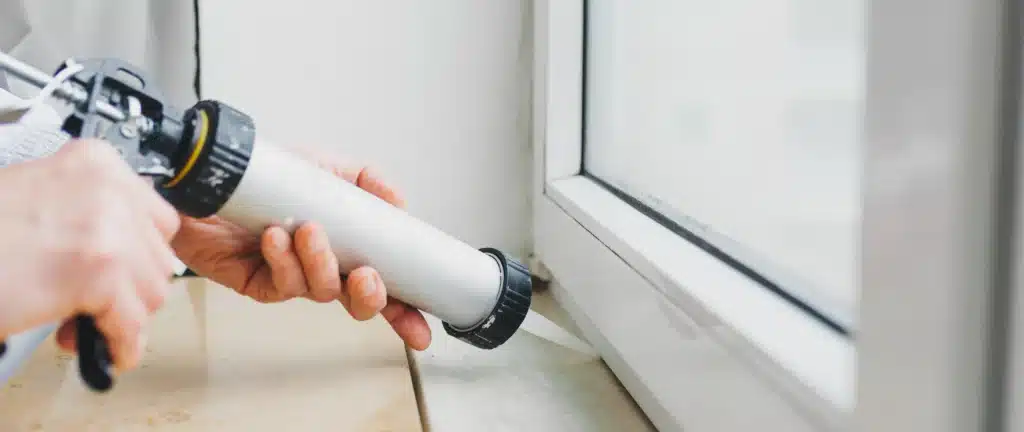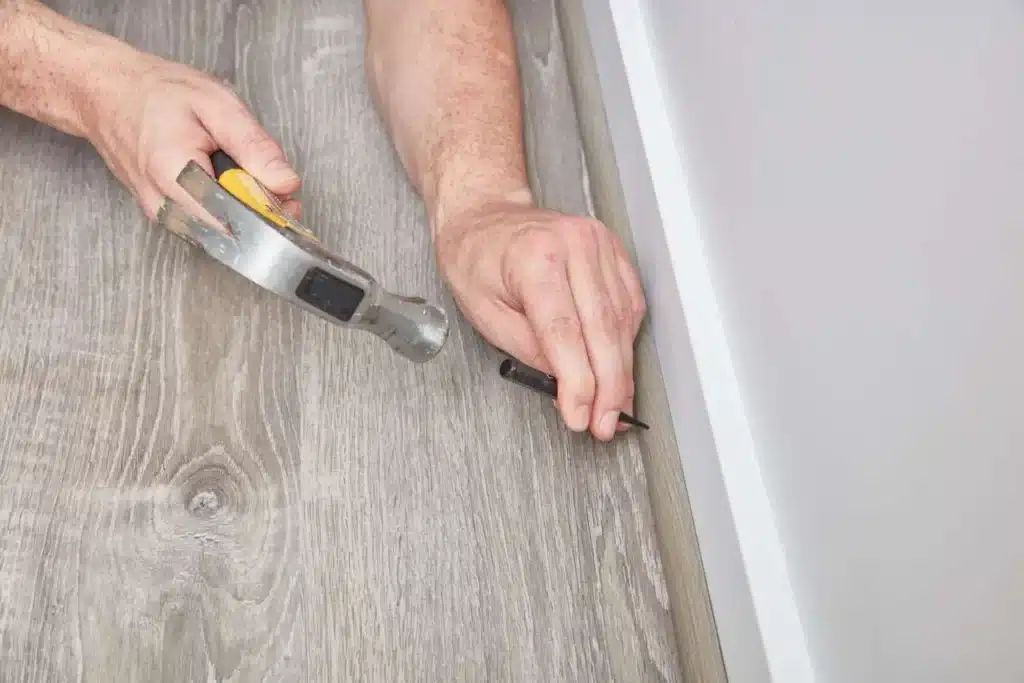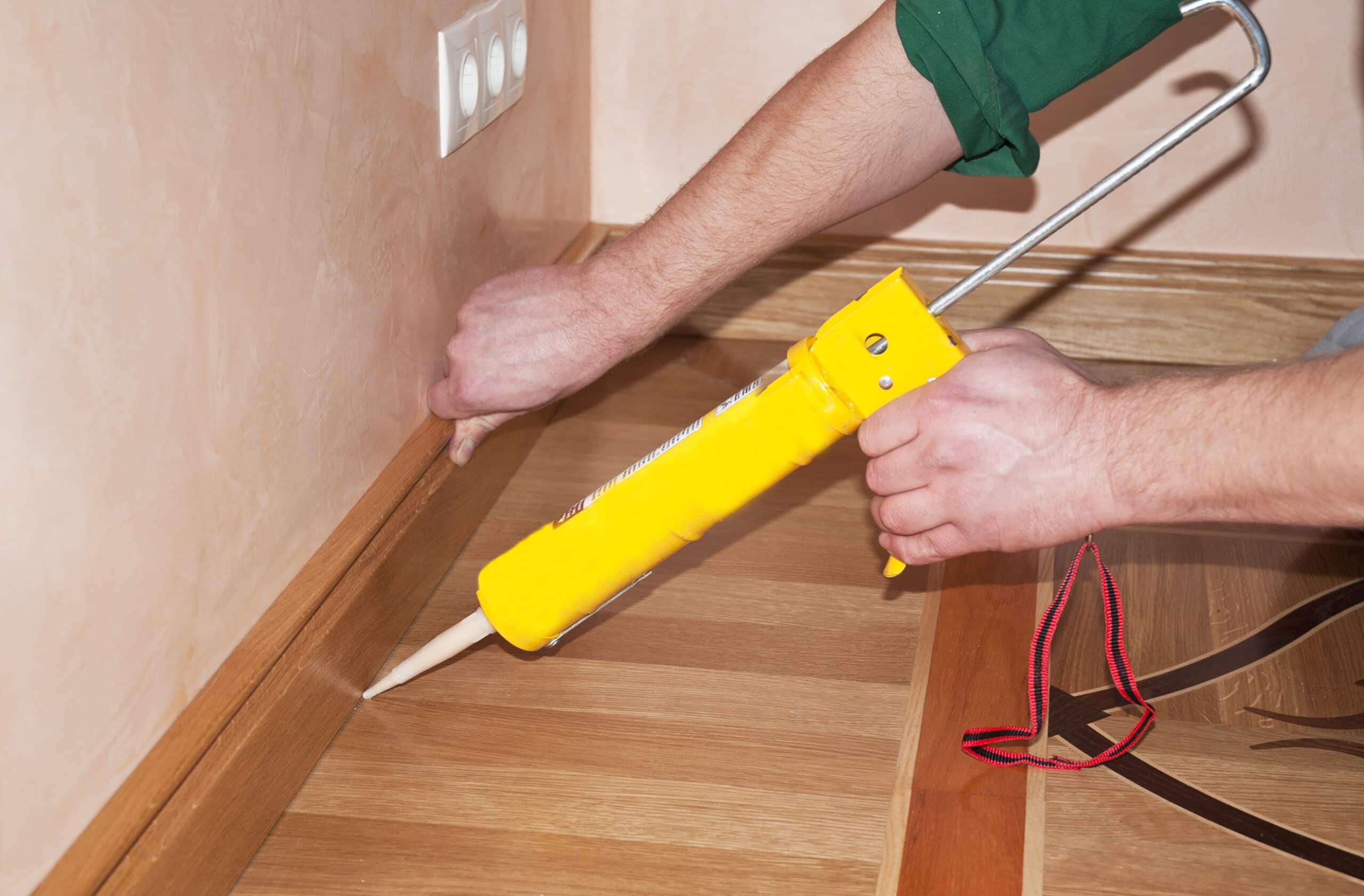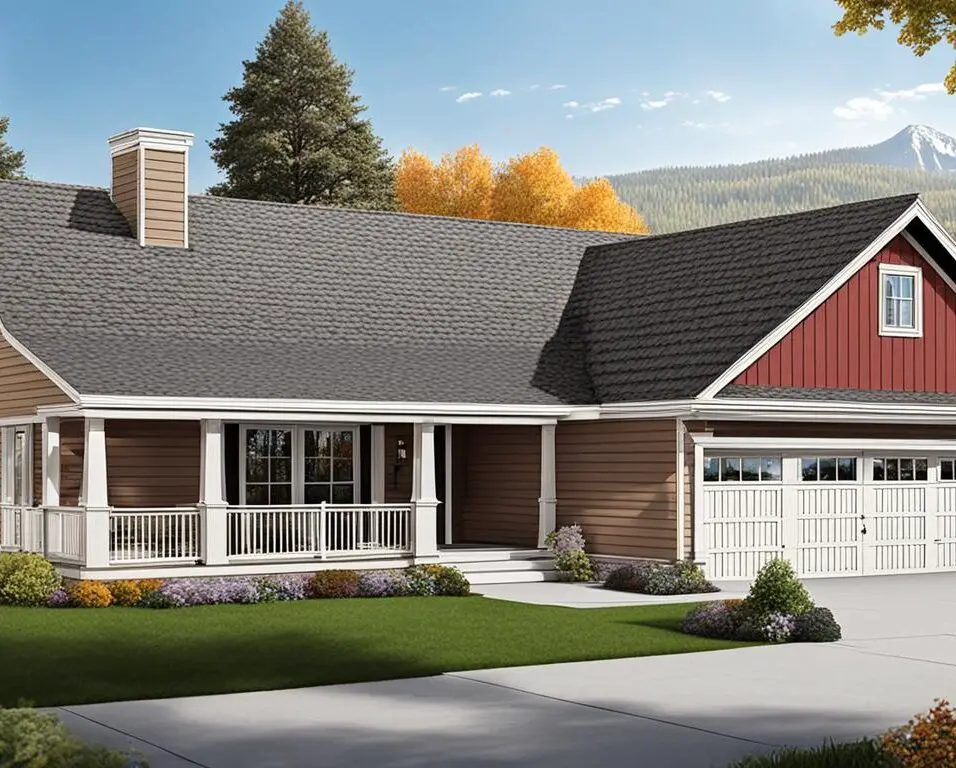How To Caulk Baseboard
Introduction
How To Caulk Baseboard: When it comes to home improvement projects, caulking baseboards may not be the most glamorous task, but it is certainly an important one. Baseboards not only add a finishing touch to a room, but they also serve a practical purpose by covering the gap between the wall and the floor. Over time, this gap can become a breeding ground for dust, dirt, and even pests. Caulking size nails baseboards is a simple and effective way to seal this gap, preventing any unwanted elements from entering your home.
Before you begin caulking, it’s important to gather all the necessary materials. You will need a caulk gun, caulk (preferably a paintable one), a putty knife or a caulk smoothing tool, a damp cloth, and painter’s tape. These materials can be easily found at your local hardware store or home improvement center.
Before applying caulk, it’s crucial to prepare the area properly. Start by thoroughly cleaning the baseboards and removing any existing caulk or paint. Use a putty knife or a caulk removal tool to scrape away any old caulk. Once the baseboards are clean and dry, use painter’s tape to mask off the edges of the baseboards and the wall. This will create clean lines and prevent any accidental smudging of caulk onto the wall.
Now it’s time to apply the caulk. Load the caulk tube into the caulk gun and cut the tip of the tube at a 45-degree angle. Start at one end of the baseboard and slowly squeeze the trigger of the caulk gun, applying a thin and even bead of caulk along the gap between the baseboard and the floor. Move along the entire length of the baseboard, making sure to fill any gaps or cracks. If you accidentally apply too much caulk.

Should baseboards be caulked?
Let the Floor Caulking Set
So, is caulking between the floor and baseboard a good idea? The answer is yes! Caulking will help to seal any gaps that may exist, which in turn will help to keep pests, moisture, and air from infiltrating your home.
Baseboards are an essential part of any home’s interior design. They not only provide a finished look to a room but also protect the walls from damage. One common question that homeowners often have is whether or not baseboards should be caulked. Caulking is the process of sealing gaps and cracks to prevent air and moisture from entering or escaping a room. In the case of baseboards, caulking can help create a seamless and polished look, as well as provide additional insulation.
There are several reasons why baseboards should be caulked. First and foremost, caulking helps to create a clean and finished appearance. When baseboards are installed, there is often a small gap between the board and the wall. Caulking this gap can help create a seamless transition between the baseboard and the wall, giving the room a more polished and professional look.
Improving Energy Efficiency with Baseboard Caulking
In addition to aesthetics, caulking baseboards can also help improve energy efficiency. The small gaps between the baseboard and the wall can allow air to escape or enter a room, leading to drafts and increased energy consumption. By caulking these gaps, homeowners can help create a more airtight seal, reducing energy loss and potentially lowering utility bills.
Another benefit of caulking baseboards is that it can help prevent moisture damage. Moisture can seep into the gaps between the baseboard and the wall, leading to mold and mildew growth. By caulking these gaps, homeowners can create a barrier that prevents moisture from entering and causing damage.
It is important to note that not all baseboards need to be caulked. In some cases, baseboards may be installed flush against the wall, eliminating the need for caulking. Additionally, if the baseboards are made of a material that expands and contracts with temperature changes, caulking may not be recommended as it can restrict movement and cause the baseboards to crack.
What is the purpose of caulking baseboards?
In addition to filling gaps and making the joinery look flawless, this sealant serves as an important barrier to keep both critters and drafts out of spaces where they shouldn’t be. Plus, caulk fills in dust-collecting crevices, making baseboards easier to clean.
Caulking baseboards serves several important purposes. First and foremost, it helps to create a seamless and finished look between the baseboards and the walls. Without caulking, there can be gaps and cracks between the baseboards and the walls, which can be unsightly and allow for the accumulation of dust and dirt. By caulking these gaps, you can create a clean and polished appearance in your home.
Additionally, caulking baseboards helps to improve the overall energy efficiency of your home. Gaps and cracks between the baseboards and the walls can allow for drafts to enter your home, leading to increased energy consumption and higher utility bills. By sealing these gaps with caulk, you can prevent air leakage and improve the insulation of your home.
Protecting Against Moisture: The Role of Baseboard Caulking
Another important purpose of caulking baseboards is to provide protection against moisture. Moisture can seep into the gaps between the baseboards and the walls, leading to water damage, mold growth, and other issues. By caulking these gaps, you can create a barrier that prevents moisture from entering and causing damage to your walls and baseboards.
In addition to these practical purposes, caulking baseboards can also help to enhance the overall aesthetic appeal of your home. By creating a seamless and finished look, caulking can make your baseboards appear more polished and professional. This can contribute to a more cohesive and visually pleasing interior design.
Overall, the purpose of caulking baseboards is to create a clean and finished look, improve energy efficiency, provide protection against moisture, and enhance the overall aesthetic appeal of your home. It is a simple and cost-effective way to improve the appearance and functionality of your baseboards and walls.
What happens if you don’t caulk baseboards?
Painted baseboards without caulk often show visible gaps that suggest sloppy workmanship and leave the whole room looking rough. Caulk smooths the transition between the baseboard and surrounding surfaces for a more refined appearance.
If you don’t caulk baseboards, you may be leaving your home vulnerable to a variety of issues. Baseboards are the trim that runs along the bottom of your walls, covering the joint between the wall and the floor. Caulking is the process of sealing this joint with a waterproof material, such as silicone or acrylic caulk. It is an important step in finishing a room and can provide several benefits.
One of the main reasons to caulk baseboards is to prevent drafts and air leaks. Gaps between the baseboards and the wall can allow cold air to enter your home during the winter months and hot air to enter during the summer. This can lead to increased energy costs as your heating and cooling systems have to work harder to maintain a comfortable temperature. Caulking the baseboards helps to create a tight seal, preventing air from escaping or entering your home.
Preventing Water Damage: The Importance of Caulking Baseboards
Caulking baseboards also helps to keep out moisture and water. If there are gaps between the baseboards and the wall, water can seep in and cause damage to the walls, flooring, and even the structure of your home. Moisture can lead to mold and mildew growth, which can be harmful to your health and difficult to remove. By caulking the baseboards, you create a barrier that prevents water from entering your home and causing these issues.
In addition to preventing drafts and moisture, caulking baseboards can also improve the appearance of a room. Gaps between the baseboards and the wall can be unsightly, especially if they are large or uneven. Caulking fills in these gaps, creating a smooth and seamless transition between the wall and the floor. This can give your room a more finished and polished look.
Overall, caulking baseboards is an important step in maintaining the integrity and appearance of your home. It helps to prevent drafts, keep out moisture, and improve the overall aesthetic of a room. If you neglect to caulk your baseboards, you may be putting your home at risk for increased energy costs, water damage, and a less appealing living space. Taking the time to properly caulk your baseboards is a simple and cost-effective way to protect your home and ensure its longevity.
Is silicone or caulk better for baseboards?
For interior baseboards, you’re going to want to use a type of caulk that is durable, flexible, seals out water, and supports the room’s aesthetics. We recommend using a latex-acrylic caulk with added silicone.
Silicone is a versatile material that is known for its durability and flexibility. It is resistant to moisture, temperature changes, and UV rays, making it an excellent choice for areas that are exposed to water or sunlight. Silicone is also known for its long-lasting properties, as it does not crack or shrink over time. Additionally, silicone is available in a wide range of colors, allowing for seamless integration with the baseboard and the wall.
Choosing the Right Caulk for Baseboards: Types and Considerations
When deciding between silicone and caulk for baseboards, it is important to consider the specific requirements of the project. If the baseboards are located in an area that is prone to moisture or temperature changes, silicone may be the better option due to its superior resistance to these factors. On the other hand, if the baseboards are in an area that is not exposed to water or sunlight, caulk may be a more cost-effective choice.
Both silicone and caulk have their own advantages and disadvantages when it comes to sealing baseboards. The choice between the two depends on factors such as the specific requirements of the project and personal preferences. It is recommended to consult with a professional or conduct thorough research before making a decision.
What caulk is best for baseboards?
Baseboard Caulk Selection
We recommend using a latex-acrylic caulk with added silicone. Latex-Acrylic-Silicone caulk products are available in different colours to better match flooring or baseboard paint colour. They adhere well to wood, MDF, and composite baseboards and have enough flexibility to minimize cracking.
When it comes to baseboards, choosing the right caulk is essential for a clean and professional finish. The right caulk not only helps to seal gaps and cracks but also enhances the overall appearance of the baseboards. With so many options available in the market, it can be overwhelming to determine which caulk is best for baseboards. However, by considering a few key factors, you can easily find the perfect caulk for your baseboards.
One important factor to consider when choosing caulk for baseboards is the type of material the baseboards are made of. Different materials require different types of caulk. For example, if your baseboards are made of wood, it is best to use a caulk that is specifically designed for wood surfaces. This type of caulk is flexible and can withstand the natural expansion and contraction of wood without cracking or splitting. On the other hand, if your baseboards are made of PVC or vinyl, a caulk that is compatible with these materials should be used.
Selecting the Right Caulk Color for Seamless Baseboard Integration
Another factor to consider is the color of the caulk. While most caulk comes in a standard white color, there are also options available in various shades to match the color of your baseboards. Using a caulk that matches the color of your baseboards helps to create a seamless and professional look. Additionally, some caulk can be painted over, allowing you to further customize the color to match your baseboards.
The durability and flexibility of the caulk are also important considerations. Baseboards are subject to movement and temperature changes, so it is crucial to choose a caulk that can withstand these conditions. Look for a caulk that is labeled as flexible and durable, as this will ensure that it can withstand the test of time without cracking or shrinking.
Lastly, consider the ease of application and cleanup. Some caulk requires special tools or techniques for application, while others can be easily applied with a standard caulk gun. Similarly, some caulk can be easily cleaned up with water, while others require solvents for removal. Consider your skill level and preferences when choosing a caulk that is easy to work with and clean up.
To caulk baseboards, you will need a few essential materials. Firstly, you will need a caulk gun to apply the caulk. Make sure to choose a caulk gun that is compatible with the type of caulk you are using. Additionally, you will need a tube of caulk that is suitable for baseboards. Silicone or acrylic latex caulk are commonly used for this purpose.
What are the steps to properly prepare baseboards for caulking?
Before caulking baseboards, it is important to properly prepare them to ensure a successful and long-lasting result. The first step is to thoroughly clean the baseboards. Use a mild detergent and water solution to remove any dirt, dust, or grease. Allow the baseboards to dry completely before proceeding.
Next, inspect the baseboards for any cracks, gaps, or loose sections. Use a utility knife or caulk removal tool to carefully remove any old caulk or debris from these areas. It is crucial to create a clean and smooth surface for the new caulk to adhere to.
Once the baseboards are clean and free of old caulk, use a putty knife or caulk smoothing tool to apply a thin layer of caulk along the edges of the baseboards. Be sure to fill any gaps or cracks completely. Smooth the caulk with the tool to create a seamless finish. Allow the caulk to dry and cure according to the manufacturer’s instructions before painting or applying any additional finishes.
How do you apply caulk to baseboards for a seamless finish?
To achieve a seamless finish when applying caulk to baseboards, follow these steps. Start by loading the caulk tube into the caulk gun and cutting the tip of the caulk tube at a 45-degree angle. This will allow for a smooth and controlled application.
In addition to the caulk and caulk gun, you will need a utility knife or caulk removal tool to remove any old caulk or debris from the baseboards. A putty knife or a caulk smoothing tool will also be necessary to create a smooth and even finish. Lastly, have a damp cloth or sponge on hand to clean up any excess caulk or to wipe away any mistakes.
What materials are needed to caulk baseboards?
To properly you will need a few essential materials. Firstly, you will need a caulk gun to apply the caulk. Make sure to choose a caulk gun that is compatible with the type of caulk you are using. Additionally, you will need a tube of caulk that is suitable for baseboards. Silicone or acrylic latex caulk are commonly used for this purpose.
Other materials you will need include a utility knife or caulk removal tool to remove any old caulk or debris from the baseboards. You will also need a caulk smoothing tool or a damp cloth to create a seamless finish. Lastly, have a bucket of water and some soap handy to clean up any excess caulk or tools.
By gathering these materials before starting the caulking process, you will ensure that you have everything you need to achieve a professional-looking result.
How do you apply caulk to baseboards for a seamless finish?
When applying caulk to baseboards for a seamless finish, there are a few important steps to follow. First, gather all the necessary materials, including caulk, a caulk gun, a putty knife, and a damp cloth. It’s important to choose a high-quality caulk that is specifically designed for baseboards and trim.
Before applying the caulk, make sure the baseboards are clean and free of any dust or debris. Use a damp cloth to wipe down the surface and remove any dirt. Next, use a putty knife to remove any old caulk or paint that may be present. This will ensure a smooth and even application of the new caulk.
Are there any specific techniques or tips for smoothing caulk on baseboards?
When it comes to smoothing caulk on baseboards, there are a few techniques and tips that can help you achieve a seamless finish. Firstly, it’s important to choose the right caulk for the job. Opt for a high-quality, paintable caulk that is specifically designed for use on baseboards. This will ensure better adhesion and a smoother finish.
Before applying the caulk, make sure to properly prepare the baseboards. Clean the surface thoroughly to remove any dust, dirt, or debris. Use a putty knife or scraper to remove any old caulk or paint that may be present. This will create a clean and smooth surface for the new caulk to adhere to.
When applying the caulk, use a caulk gun for better control and precision. Start by cutting the tip of the caulk tube at a 45-degree angle to create a small opening. Apply a thin and even bead of caulk along the baseboard, making sure to fill any gaps or cracks. Use a caulk smoothing tool or your finger to smooth the caulk, working in a continuous motion along the entire length of the baseboard.
How long does it typically take for caulk on baseboards to dry and cure?
When it comes to drying and curing time for caulk on baseboards, it can vary depending on several factors. The type of caulk being used, the temperature and humidity of the environment, and the thickness of the caulk application all play a role in the drying and curing process.
In general, most caulk products will dry to the touch within 30 minutes to an hour. However, it is important to note that this is just the surface drying time and the caulk may still be soft and not fully cured. It is recommended to wait at least 24 hours before subjecting the caulked baseboards to any stress or movement.
During the curing process, the caulk will continue to harden and reach its maximum strength. This can take anywhere from 24 hours to several days, depending on the specific caulk product. It is important to follow the manufacturer’s instructions for the recommended curing time to ensure the best results.

Conclusion
Overall, learning how to caulk baseboards is a valuable skill that can greatly improve the appearance and functionality of your home. By following the step-by-step process outlined above, you can ensure that your baseboards are properly sealed and protected against moisture and drafts. Additionally, caulking baseboards can help to prevent the growth of mold and mildew, which can be harmful to both your health and the structural integrity of your home.
One of the key benefits of caulking baseboards is the aesthetic improvement it provides. By filling in gaps and cracks, caulking can create a seamless and polished look, giving your baseboards a professional and finished appearance. This can greatly enhance the overall visual appeal of your home, making it more attractive to potential buyers or guests.
Furthermore, caulking baseboards can also help to improve the energy efficiency of caulk baseboards your home. By sealing gaps and cracks, caulking prevents drafts from entering your home, reducing the amount of air that needs to be heated or cooled. This can lead to significant energy savings and lower utility bills, making caulking a cost-effective home improvement project.
Knowing how to caulk baseboards is a valuable skill that can improve the appearance, functionality, and energy efficiency of your home. By following the step-by-step process outlined above, you can ensure that your baseboards are properly sealed and protected against moisture and drafts. Additionally, caulking baseboards can enhance the overall aesthetic appeal of your home and help to reduce energy consumption, leading to cost savings in the long run. So, whether you are looking to update the look of your home or improve its energy efficiency, caulking baseboards is a worthwhile investment.








